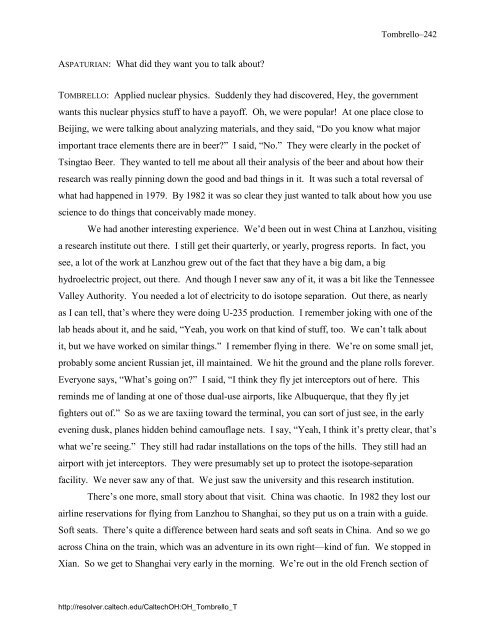Interview with Thomas A. Tombrello - Caltech Oral Histories
Interview with Thomas A. Tombrello - Caltech Oral Histories
Interview with Thomas A. Tombrello - Caltech Oral Histories
Create successful ePaper yourself
Turn your PDF publications into a flip-book with our unique Google optimized e-Paper software.
<strong>Tombrello</strong>–242<br />
ASPATURIAN: What did they want you to talk about?<br />
TOMBRELLO: Applied nuclear physics. Suddenly they had discovered, Hey, the government<br />
wants this nuclear physics stuff to have a payoff. Oh, we were popular! At one place close to<br />
Beijing, we were talking about analyzing materials, and they said, “Do you know what major<br />
important trace elements there are in beer?” I said, “No.” They were clearly in the pocket of<br />
Tsingtao Beer. They wanted to tell me about all their analysis of the beer and about how their<br />
research was really pinning down the good and bad things in it. It was such a total reversal of<br />
what had happened in 1979. By 1982 it was so clear they just wanted to talk about how you use<br />
science to do things that conceivably made money.<br />
We had another interesting experience. We’d been out in west China at Lanzhou, visiting<br />
a research institute out there. I still get their quarterly, or yearly, progress reports. In fact, you<br />
see, a lot of the work at Lanzhou grew out of the fact that they have a big dam, a big<br />
hydroelectric project, out there. And though I never saw any of it, it was a bit like the Tennessee<br />
Valley Authority. You needed a lot of electricity to do isotope separation. Out there, as nearly<br />
as I can tell, that’s where they were doing U-235 production. I remember joking <strong>with</strong> one of the<br />
lab heads about it, and he said, “Yeah, you work on that kind of stuff, too. We can’t talk about<br />
it, but we have worked on similar things.” I remember flying in there. We’re on some small jet,<br />
probably some ancient Russian jet, ill maintained. We hit the ground and the plane rolls forever.<br />
Everyone says, “What’s going on?” I said, “I think they fly jet interceptors out of here. This<br />
reminds me of landing at one of those dual-use airports, like Albuquerque, that they fly jet<br />
fighters out of.” So as we are taxiing toward the terminal, you can sort of just see, in the early<br />
evening dusk, planes hidden behind camouflage nets. I say, “Yeah, I think it’s pretty clear, that’s<br />
what we’re seeing.” They still had radar installations on the tops of the hills. They still had an<br />
airport <strong>with</strong> jet interceptors. They were presumably set up to protect the isotope-separation<br />
facility. We never saw any of that. We just saw the university and this research institution.<br />
There’s one more, small story about that visit. China was chaotic. In 1982 they lost our<br />
airline reservations for flying from Lanzhou to Shanghai, so they put us on a train <strong>with</strong> a guide.<br />
Soft seats. There’s quite a difference between hard seats and soft seats in China. And so we go<br />
across China on the train, which was an adventure in its own right—kind of fun. We stopped in<br />
Xian. So we get to Shanghai very early in the morning. We’re out in the old French section of<br />
http://resolver.caltech.edu/<strong>Caltech</strong>OH:OH_<strong>Tombrello</strong>_T

















